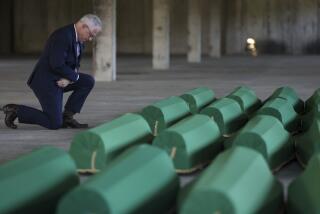Changing Lifestyles : Bosnian Village Goes From Rags to Riches--and Back : Medjugorje enjoyed a religious tourist boom in the 1980s until war drove away the visitors. Now U.N. troops camp there.
- Share via
MEDJUGORJE, Bosnia-Herzegovina — It was the boom time of the late 1980s, when Medjugorje’s only paved thoroughfare was bumper to bumper with air-conditioned buses, that convinced Nikola Karacic to move from the tourist town of Mostar to this desolate highland village.
Roman Catholic pilgrims were then arriving by the hundreds, even thousands, most days, to walk the hallowed hilltop where six Croatian children claimed to have seen and conversed with the Virgin Mary.
“Business was good then,” recalls Karacic, a 27-year-old pizzeria owner, who jumped into the development frenzy that has transformed tiny Medjugorje from a dirt-farming backwater to a neon-lighted center of commerce.
But the change inflicted on Medjugorje by the vision and the flood of religious tourists that followed was just the first of many chaotic transformations for the people of this village. Their lives have been tethered to the juggernaut of recent East European history.
Medjugorje has been on a 13-year roller-coaster ride, rocketing to fame and fortune as a place of pilgrimage after the children’s vision of 1981, only to crash into tourist doldrums three years ago, when war began to consume the surrounding territory.
In the decade between boom and bust, the village, like all of the former Yugoslavia, watched its political structure and security crumble as the Communist federation fractured.
Now the site of one of the largest U.N. peacekeeping deployments in the Balkans and a front-line bivouac for aid workers and the Western press, Medjugorje has had to adjust to its latest role as a military staging ground.
More than 1,400 Spanish troops and military observers of the U.N. command have set up camp at the foot of the rocky hill where the purported vision occurred. The mission has swallowed a cluster of whitewashed bungalows that housed religious pilgrims. It now serves as a barracks for U.N. soldiers trying to sort out one facet of Bosnia’s three-sided war.
While the peacekeepers’ number would seem to compensate for the lost pilgrim traffic that came in spring and summer, Medjugorje residents whose livelihoods were built around the restaurant, souvenir and hotel patronage of the religious tourists complain that the soldiers rarely venture outside their compound.
“We don’t get any business from them,” grouses taxi driver Stipe Sego. “They just stay at their base all night. We hardly ever see them.”
That’s not entirely a bad thing, in the view of some villagers who feel war and hardship have further burdened a simple community that had already been sent reeling by the influx of foreigners spurred by the apparition.
Lilja Culjak, for instance, worked at a nearby textile factory for 30 years to augment the meager proceeds of the family farm run by her husband, daughter and three sons. But an artillery shell destroyed the factory during the early days of the Serbian rebellion against Bosnian independence. So she turned to making lace doilies and tablecloths in hopes of selling them to the trickle of tourists.
“People are nervous. They’re afraid to come here--they think they’ll be shot,” laments Culjak, who says she is on the verge of abandoning lace-making.
The rocky landscape outside Medjugorje has been repopulated by locals who once made their living taking in tourists or working in the gaudy strip of restaurants, shops and bars. They have returned to the fields that in pre-apparition years at least fed them.
Some here are heartened by what appears to be yet another change on the horizon. A U.S.-brokered peace pact announced March 1 in Washington has triggered movement toward reuniting Bosnian Croats and Muslims who had been battling for the past year.
In nearby Mostar, the heavy artillery that had been blasting Muslims has fallen silent, and residents in both halves of the segregated city are allowing themselves thoughts of reconciliation.
If the peace lasts and Western promises of assistance in rebuilding the economy are fulfilled, reconstruction could get under way on the accommodations and revered monuments that drew tourists to this area for centuries.
Mostar’s Stari Most, or Old Bridge, for which the riverfront city was named, was one of the former Yugoslavia’s most popular tourist sites and a symbol of the Balkan marriage of Eastern and Western culture. The 400-year-old limestone relic of the Ottoman Empire was damaged during a two-month artillery barrage by Serbian rebels in 1992, then finished off by Croatian nationalists during an attack on the Muslim-held east bank last October.
“I think it is going to be a lot better here soon,” says Divna Lovric, a 23-year-old shop clerk selling souvenirs along Medjugorje’s business strip. “It is in everyone’s interest to preserve the peace, because otherwise the foreigners won’t come back here.”
*
Some Catholic pilgrims have continued to visit, despite the dangers of a nearby war, and they too express hope for a new wave of prosperity for Medjugorje.
“The atmosphere is already much better here, because there used to be communism, and now that’s gone,” says H’Eloise Cunningham of Bozeman, Mont., visiting with a religious tour group.
The war, if it really is over, hasn’t left without traces. Most local families saw their fighting-age males drafted into the Bosnian Croat army that first deflected Serbian rebel attacks, then succumbed to fighting with Muslim allies over control of the sparse Bosnian territory that was left.
“For those who lost loved ones, the war will never really be over,” says Karacic, the pizzeria owner, who counts himself among the fortunate for having lost only his home to the shelling.
“But I think everyone is hoping that this stage of our lives is over and we can get back to working.”
More to Read
Sign up for Essential California
The most important California stories and recommendations in your inbox every morning.
You may occasionally receive promotional content from the Los Angeles Times.














